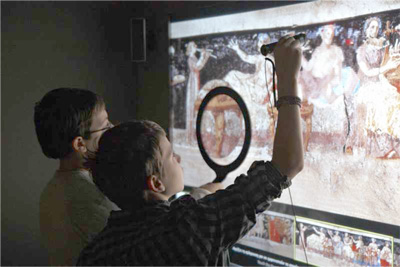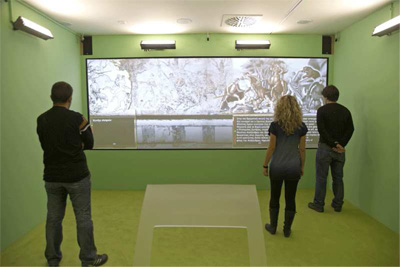by Xenophon Zabulis, Dimitrios Grammenos, Antonis A. Argyros, Michalis Sifakis and Constantine Stephanidis
Forget all about the traditional "Do Not Touch" museum rule! In 2010, the Institute of Computer Science of the Foundation for Research and Technology – Hellas (ICS-FORTH) and the Archaeological Museum of Thessaloniki (AMTh) collaborated in the creation of a special exhibition of prototypical interactive systems with subjects drawn from ancient Macedonia, named "Macedonia from fragments to pixels" (see link below). The exhibition is hosted by the AMTh at its premises and is open to the general public.
The exhibition comprises seven interactive systems which are based on some of the research outcomes of the Ambient Intelligence Programme of ICS-FORTH. The digital content of these systems includes objects from the Museum’s permanent collection and other objects related to Macedonia. In brief, the interactive systems are:
- Panoptes, a digital exhibition-catalogue system which allows visitors to browse its content and examine details of images, read accompanying texts and follow threads of information. A children’s windmill is located between two touch screens. Blowing on the windmill, the largest collection of gold wreaths in the world unfolds before the visitor. By pausing on any image, additional information is provided on about the wreath and its symbolisms.
- Cryptolexon, the hidden crossword, is a game loved by all ages, which combines entertainment with education. The names of ancient gods and heroes are hidden within a matrix of letters for the visitors to discover.
- Peridexion offers museum visitors the possibility of exploring an object and/or a subject in depth. In this particular case, the subject is a masterpiece of 6th c. BC Athenian black-figured pottery, known as the Crater of Lydos, which portrays the legend of the hunt of a monstrous boar in Calydonia, Aetolia. The system has a touch screen that presents a view of an object at a time. Visitors can select the object or the view they wish to see and then discover points of interest and relative multimedia information, or zoom in on any detail at will.
- Polyapton, a large interactive screen that can be used by several visitors who all wish to explore simultaneously multifaceted information on a subject. It presents one of the best-preserved ancient Greek paintings, from the Macedonian tomb of Agios Athanasios near Thessaloniki depicting a symposium. The tomb is not open to visitors, so Polyapton provides a rare opportunity to enjoy it. The multi-touch screen recognizes the touch of many fingers or hands, but also specific objects, at the same time. Visitors can ‘scroll’ across the painting and focus on points of interest with multimedia information by touching them, zoom in on details with the use of a paper magnifying lens, while an infrared torch displays a modern rendition of the painting.
- Multimodal Diverse Travel comprises a table, whose surface is covered by a printed map on which the location of various cities and other notable sites is projected. White paper tablets with a coloured frame are at the visitors’ disposal. When the magnifying glass is placed over a city, related images, videos and texts appear on the tablet. For every city there are multiple information “pages”, which can be viewed by touching virtual buttons at the bottom of the tablet.
- One day in a farmstead allows the public to visit an ancient farmstead that has been excavated at Asprovalta, near Thessaloniki, by enriching with multimedia information a scale model realized by the AMTh. By moving a white paper tablet over the areas of the farmstead, the visitor can view and learn more about the excavation findings and gain details on ancient rural life.
- Macrographia is a system that presents very large images, which visitors can explore by walking around in a room. One of the walls of this room comprises the projection screen. The projection of content on the screen depends on the location of each visitor in the room. Visitors enter the room and the system follows the movement of each one separately. The painting is divided into five sections, which correspond to the prey of the hunters. When someone stands in front of a section, depending on the distance from the screen, the image she/he views and the caption underneath change. There are four levels of information: the present state of the painting, an artist’s sketch, an artist’s modern rendition, and notable details.

Figure 1: Two young visitors exploring multiple layers of information in the electronic reproduction of a wall painting with Polyapton. Besides a finger touch, the system is sensitive to the touch of particular objects with different functionalities.

Figure 2: The Minister of Culture and Tourism of Greece explores locations of archaeological interest in Multimodal Diverse Travel. As the users move rectangular pieces of paper on the map, location-based, interactive multimedia content appears on them.

Figure 3: Macrographia presents a large artifact in actual size and updates visual content based on the location and walkthrough trajectories of visitors.
The exhibition is very different from an archaeological exhibition, as the public can have a novel relationship with exceptional artifacts of the past through the use of new technologies, enjoying an interactive experience that combines information and learning with entertainment. In this way, visitors have the opportunity to approach classical antiquity in a novel manner: by exploring digital reproductions of ancient masterpieces. Rare and fragile artifacts are now at the public’s fingertips with the use of modern and user friendly technology. All systems are multilingual and support interaction by one or multiple visitors.
This work was supported by the “Ambient Intelligence Programme” of ICS-FORTH.
Link:
[1] Macedonia: from fragments to pixels, 2010, http://www.makedonopixels.org
Please contact:
Constantine Stephanidis
ICS-FORTH, Greece
Tel. : +30 2810 391741
E-mail:










